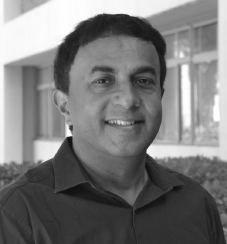Growing up in India, Dr. George Varghese had no interest in computers. Instead, he spent much of his time playing sports and reading. “I did like math,” he says. “At an early age, I learned about the binomial theorem and could see it in my head and felt like I could invent a generalization. But I was never serious about math.”
Varghese’s initial interest in networks and how they function grew out of his studies in electrical engineering at Indian Institute of Technology in Bombay. A professor returning from the University of California-Los Angeles, where Varghese is now Jonathan C. Postel Chair in networking at the Samueli School of Engineering, fired his curiosity about performance analysis of Internet routers using a queuing model.

“It was very theoretical and sparked me to create something new. It also made me read Len Kleinrock’s queueing systems book. Len is now a valued colleague of mine at UCLA and Dr. Arunkumar is still a mentor, so it seems that everything has come full circle,” he says.
Varghese’s work to boost the speed of networks, and thus the Internet itself, evolved further during his first job. While at Digital Equipment Corporation, he watched three world class products being built – the first bridge, the DECNIS router, and the Gigaswitch. He recognized the potential in the interplay between hardware design, algorithms and systems that he later developed into the textbook Network Algorithmics: An Interdisciplinary Approach to Designing Fast Networked Devices. The book was first published in 2004 and is now in its second edition.
The textbook is Varghese’s proudest professional achievement, in part, he says, because the principles in the book have held up since its first printing almost 20 years ago. “I was terrified that the world had changed so much in the interim with cloud computing, virtualization, and multicore processors. Yet it seemed to me that the principles still held. I hope they keep holding for many years hence as network technologies keep changing.”
Varghese remembers that early on, increasing speed was simply a way to prove nay-sayers wrong. “When folks said IP lookups were hard and should be replaced by something called MPLS, my students and I began to look for fast IP lookups using regular old IP. Ditto for router tasks like timers, packet classification and scheduling of packets to be sent out to ensure quality of service. So that contrarian spirit served us well, and perhaps we saw ourselves as ‘defenders of IP’ in a small way.”
As for his ongoing mission to improve the Internet’s performance, Varghese was influenced by Intel CEO Pat Gelsinger’s book, The Juggling Act: Bringing Balance to Your Faith, Family, and Work. Gelsinger describes the Internet as a modern iteration of ancient Roman roads –both made commerce and the spread of ideas and culture (from Paul’s epistles to email) faster and more reliable.
Over the last 10 years, Varghese’s work has turned to boosting the Internet’s reliability by avoiding potholes like the bugs that have been known to take down clouds like Google, Facebook and even airlines. His concentration on network verification, which began with a sabbatical at Stanford, now continues with colleagues at Microsoft Research and UCLA. This is a field that attempts to prove correctness and automatically test network router configurations and implementations.
As for the future of the Internet, Varghese points to a recent CACM paper by McCauley, Shenker and himself, how it faces serious threats from content and cloud providers who, “…֜do in-network processing to improve performance but only for their customers’… this is a tension that needs resolution. However, I am more fixated by the dream of an Internet where rather than verifying what humans have written to find bugs, we are writing a verified version of say TCP that is provably free of bugs. While folks have done so for compilers and even operating systems, this still remains a far out dream.”
When asked if he had any regrets, either professionally or personally, Varghese says it would be that his father did not live to see his success. He was a physicist, and Varghese recalls his father being concerned that his son was having trouble in science classes. “I overheard him tell someone that he thought I should aim for a career in the Indian Administrative Service because I was a better talker than I was a scientist! He would have gotten a kick out of [my induction to] the Internet Hall of Fame.”
Varghese has his own more encouraging words of wisdom for upcoming generations, whether in technical fields or not. “First, I would say don’t worry about your grades and your competence or lack thereof but find a purpose… after which other things will follow including the money you need to live.
Second, I have greatly benefited from interdisciplinary thinking. In a talk I gave, I tried to think this out a little to help folks identify worthwhile interdisciplinary work I called confluences and what I called the milieu change and inflection point. My advice to students is to seek your confluence. You don’t have to be the best in any field but you can find a mixture of fields you are good at. I recall Charlie Schultz the creator of the cartoon series Peanuts saying ‘I was never the best artist or the best writer so I became a cartoonist.’ He found his confluence!”
